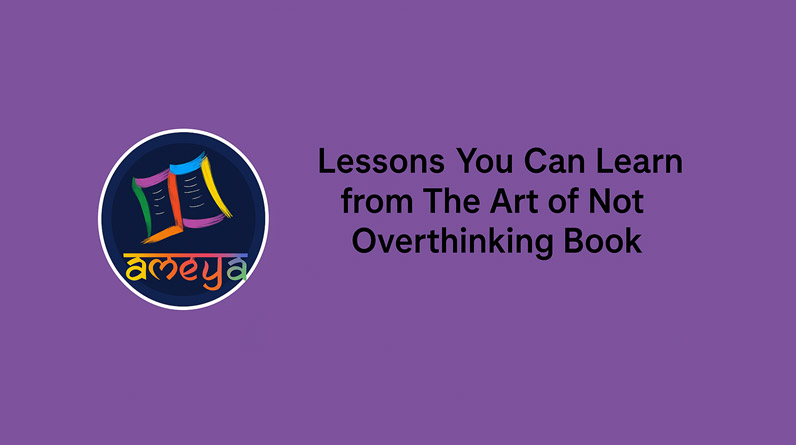If your mind often feels like a crowded railway station at rush hour — thoughts arriving and departing faster than you can catch them — then The Art of Not Overthinking Book might just be your next quiet corner.
Authored by Shaurya Kapoor, this isn’t your usual “positive thinking” manual. It doesn’t throw quick fixes or Instagram-style affirmations at you. Instead, it walks beside you, like a wise friend who has known your restless mind all along.
Today, let’s dive into the soul lessons hidden in this book — lessons that go beyond words and gently nudge you to live differently, think softly, and breathe easier.
1. Awareness Is the Beginning of Peace
Overthinking is sneaky. It disguises itself as productivity, preparation, or even care. But Shaurya Kapoor reminds us — you can’t heal what you don’t see.
The book opens with a simple truth:
“Notice when you overthink the most. It’s not about stopping thoughts — it’s about recognising them.”
And that’s profound. Because awareness isn’t resistance; it’s recognition.
Here’s a little exercise inspired by the book:
Catch yourself mid-overthink and say, “I see you.”
Write the thought down — don’t fix it, just witness it.
Observe the pattern: Does it show up at night? Around people? After failure?
When you start noticing, your mind begins to slow down. Awareness, as the author says, isn’t the cure — it’s the door.
2. You Deserve Ease — Not Endless Fixing
Overthinkers carry an invisible burden: the need to fix everything. Every situation. Every emotion. Every person.
But The Art of Not Overthinking Book insists on a radical shift — from “I must fix” to “I deserve peace.”
That’s revolutionary in a culture that glorifies busyness. The book tells you, quite boldly:
“You deserve love, you deserve healing, you deserve peace — even before everything falls into place.”
Read that again. Even before.
As Indians, we grow up with an undercurrent of constant proving — to parents, to peers, to society. This book cuts through that noise, reminding us that self-worth isn’t a trophy you win; it’s your birthright.
When that realization lands, overthinking begins to lose its grip.
3. Action Is the Antidote to Rumination
Overthinking thrives on stillness — not the peaceful kind, but the paralysing kind. The kind where you sit on your bed, looping through imaginary scenarios until your tea goes cold.
Kapoor’s advice is simple yet potent: move.
“When your thoughts begin to spiral, shift your body, not just your mind.”
Take a walk. Water a plant. Call a friend. Write a letter you’ll never send.
Because every small action pulls you out of your head and into your world. You begin to realise that the present moment, no matter how messy, is safer than the imaginary one your mind keeps creating.
And the moment you act, clarity follows like a shadow.
4. Presence Is More Powerful Than Perfection
Perfectionism and overthinking are twins — different faces of the same fear: the fear of not being enough.
The book breaks that illusion gently. It doesn’t preach, it whispers:
“You’re imperfect, and that’s exactly what makes you connect with others.”
Let that sink in. We don’t bond over our perfect days; we bond over our shared humanness — the awkward pauses, the unfiltered emotions, the silent disappointments.
When you drop the weight of perfection, something magical happens: life feels lighter. You stop replaying old mistakes like broken records. You stop rehearsing every conversation. You stop living in drafts.
And for the first time, you begin to live in the moment.
5. Grounding Yourself — The Art of Coming Home
At its core, this book isn’t about “not thinking.” It’s about coming home to the present.
When your mind time-travels — to yesterday’s regret or tomorrow’s fear — the book brings you back to now.
Try this exercise inspired by Kapoor’s reflections:
- Take a deep breath and name five things you can see.
- Feel the air — is it cool or warm?
- Listen for a sound that’s always there but rarely noticed — maybe a ceiling fan or a bird outside.
It’s astonishing how quickly such small grounding rituals calm the mind. You begin to realise: peace isn’t a place you reach — it’s something you return to.
Why Indian Readers Will Relate Deeply
In India, we live in a culture of constant comparison — grades, jobs, marriages, social milestones. The mind never stops running, calculating, replaying.
That’s why The Art of Not Overthinking Book hits home. It feels like a quiet revolution — teaching us that our value doesn’t depend on speed, success, or social validation.
This isn’t escapism. It’s emotional minimalism.
By practising awareness, acceptance, and groundedness, you don’t escape reality — you simply learn to stop fighting it.
BooksAmyea’s Reflection: A Mirror, Not a Manual
At BooksAmyea, we believe some books don’t teach you; they transform you.
The Art of Not Overthinking is one such book. It doesn’t hand you a list of rules. It shows you the mirror and lets you meet yourself — the real, unpolished, quietly strong version.
So, when you close the last page, don’t just ask what did I learn? Ask, who did I become?
Because this isn’t a book you finish.
It’s a practice you live.
Final Thought
If your mind is a storm, let The Art of Not Overthinking Book be your umbrella.
Not to stop the rain — but to remind you that you can walk through it, gently, without drowning.
So tonight, when your brain begins its familiar marathon, whisper softly:
“I deserve calm. I deserve ease.”
And maybe, for once, your thoughts will listen.
FAQs
1. What is The Art of Not Overthinking Book about?
Ans. It’s a self-help guide by Shaurya Kapoor, offering gentle yet practical lessons on calming the mind, cultivating self-belief, and reclaiming mental peace.
2. Who should read this book?
Ans. Anyone who overthinks — whether you’re an emotional soul, a chronic perfectionist, or someone who can’t stop replaying “what ifs” at night.
3. What’s the key takeaway from this book?
Ans. You don’t have to silence your thoughts. You only need to stop giving them all the power.
4. Is it relatable for Indian readers?
Ans. Absolutely. The language is simple, heartfelt, and emotionally resonant with everyday Indian experiences — from familial expectations to self-doubt.
5. How can I apply its lessons in daily life?
Ans. Keep a short “thought journal”
Replace self-criticism with self-compassion
Take small, mindful actions
Pause and ground yourself in the present moment



